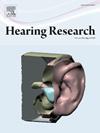支持细胞参与耳蜗损伤和修复:来自环糊精诱导的小鼠耳毒性定量分析的新见解
IF 2.5
2区 医学
Q1 AUDIOLOGY & SPEECH-LANGUAGE PATHOLOGY
引用次数: 0
摘要
耳蜗易受各种病理条件的影响,感觉细胞通常是损伤的主要目标。然而,支持细胞也会受到重大影响。尽管它们在维持感觉上皮的结构和功能完整性方面起着关键作用,但支持细胞在耳蜗损伤中的作用仍然知之甚少。本研究旨在阐明支持细胞在耳蜗损伤中的易感性及其在结构修复中的作用,使用环糊精(一种已知在高剂量下优先损伤外毛细胞的葡萄糖环低聚物)诱导的小鼠耳毒性模型。耳蜗的形态学检查表明,环糊精暴露引起了明显的感觉细胞损失,特别是影响耳蜗螺旋上的外毛细胞,除了耳蜗顶端。尽管广泛的毛细胞损伤,大多数支持细胞在耳蜗顶端和中间区域存活。在基底端,大量支持细胞丢失,某些deiter细胞甚至在失去指骨突后存活。此外,我们的观察表明,当Corti器官塌陷时,Hensen细胞有助于在基底膜上形成一层上皮。进一步的定量分析揭示了支持细胞类型之间的位置依赖性易感性。deiter细胞表现出比柱状细胞更强的弹性。值得注意的是,三行deiter细胞表现出不同的易感性:第三行在散发性deiter细胞损失区域表现出更显著的损失,而第一行在完全deiter细胞耗尽区域附近的区域表现出增加的损失。Hensen细胞的减少开始于耳蜗中部,比Deiters细胞和柱状细胞的减少程度更大。然而,在极端底部,柱状细胞和德特氏细胞大部分或完全缺失,一些亨森细胞仍然存在。总之,这些发现为支持细胞对耳蜗损伤的不同脆弱性提供了新的见解,并强调了它们在结构修复中的重要作用。本文章由计算机程序翻译,如有差异,请以英文原文为准。
Supporting cell involvement in cochlear damage and repair: Novel insights from a quantitative analysis of cyclodextrin-induced ototoxicity in mice
The cochlea is vulnerable to various pathological conditions, with sensory cells typically being the primary targets of damage. However, supporting cells also experience significant impacts. Despite their critical role in maintaining the structural and functional integrity of the sensory epithelium, the supporting cell involvement in cochlear damage remains poorly understood. This study aimed to elucidate the susceptibility of supporting cells in cochlear damage and their role in structural repair, using a mouse model of ototoxicity induced by cyclodextrin—a cyclic oligomer of glucose that is known to preferentially damage outer hair cells at high doses. A morphological examination of the cochlea showed that cyclodextrin exposure caused significant sensory cell loss, particularly affecting outer hair cells across the cochlear spiral, except at the apex. Despite extensive hair cell damage, most supporting cells in the apical and middle cochlear regions survived. In the basal end, where substantial supporting cell loss occurred, certain Deiters’ cells survived even after losing their phalangeal processes. Additionally, our observations indicate that Hensen's cells contribute to forming an epithelial layer over the basilar membrane when the organ of Corti collapses. Further quantitative analysis revealed location-dependent susceptibility among supporting cell types. Deiters’ cells demonstrated greater resilience than pillar cells. Notably, the three rows of Deiters’ cells displayed differential susceptibility: the third row showed a more significant loss in regions with sporadic Deiters’ cell loss, while the first row exhibited an increased loss in areas adjacent to regions of complete Deiters’ cell depletion. The reduction of Hensen's cells started in the middle section of the cochlea, occurring at a greater level than the reduction observed in Deiters’ and pillar cells. However, in the extreme base, where both pillar and Deiters’ cells were largely or completely absent, some Hensen's cells were still present. Together, these findings provide new insights into the varying vulnerability of supporting cells to cochlear damage and underscore their essential role in structural repair.
求助全文
通过发布文献求助,成功后即可免费获取论文全文。
去求助
来源期刊

Hearing Research
医学-耳鼻喉科学
CiteScore
5.30
自引率
14.30%
发文量
163
审稿时长
75 days
期刊介绍:
The aim of the journal is to provide a forum for papers concerned with basic peripheral and central auditory mechanisms. Emphasis is on experimental and clinical studies, but theoretical and methodological papers will also be considered. The journal publishes original research papers, review and mini- review articles, rapid communications, method/protocol and perspective articles.
Papers submitted should deal with auditory anatomy, physiology, psychophysics, imaging, modeling and behavioural studies in animals and humans, as well as hearing aids and cochlear implants. Papers dealing with the vestibular system are also considered for publication. Papers on comparative aspects of hearing and on effects of drugs and environmental contaminants on hearing function will also be considered. Clinical papers will be accepted when they contribute to the understanding of normal and pathological hearing functions.
 求助内容:
求助内容: 应助结果提醒方式:
应助结果提醒方式:


